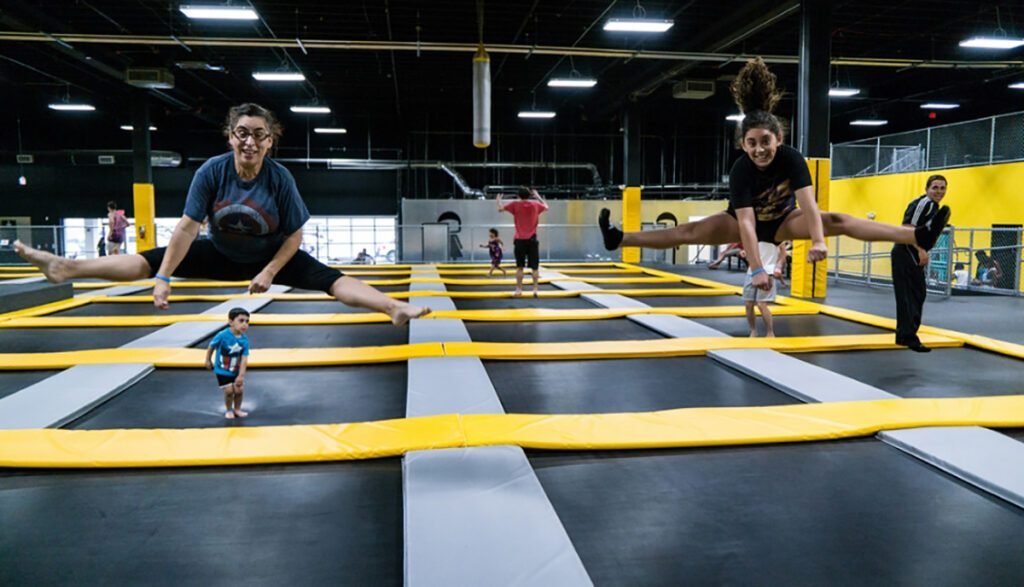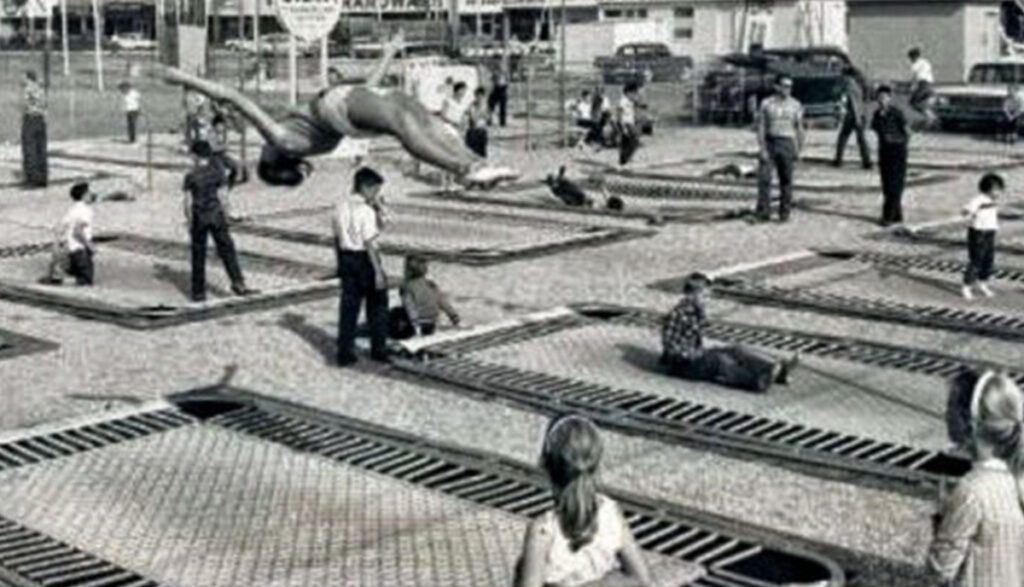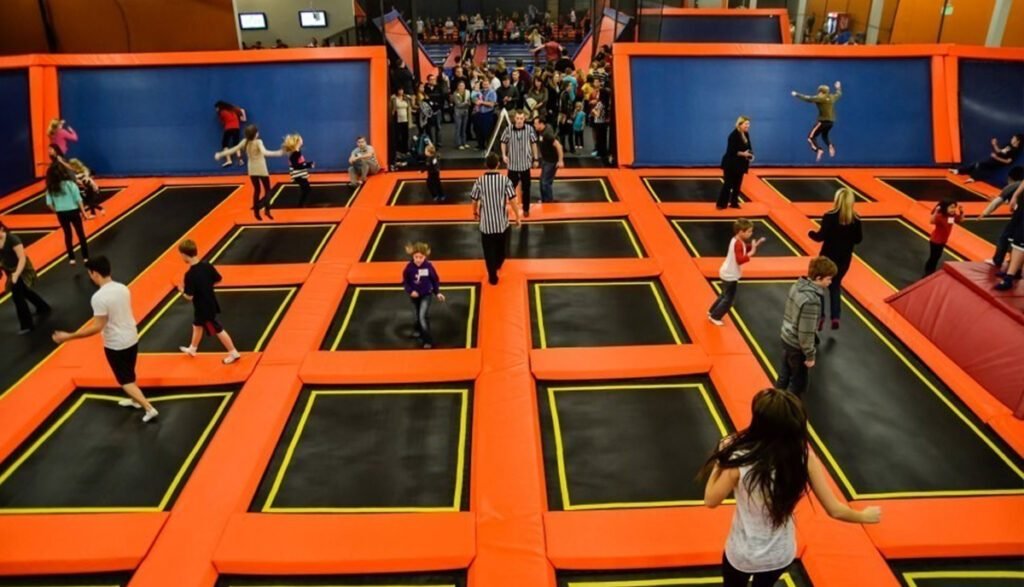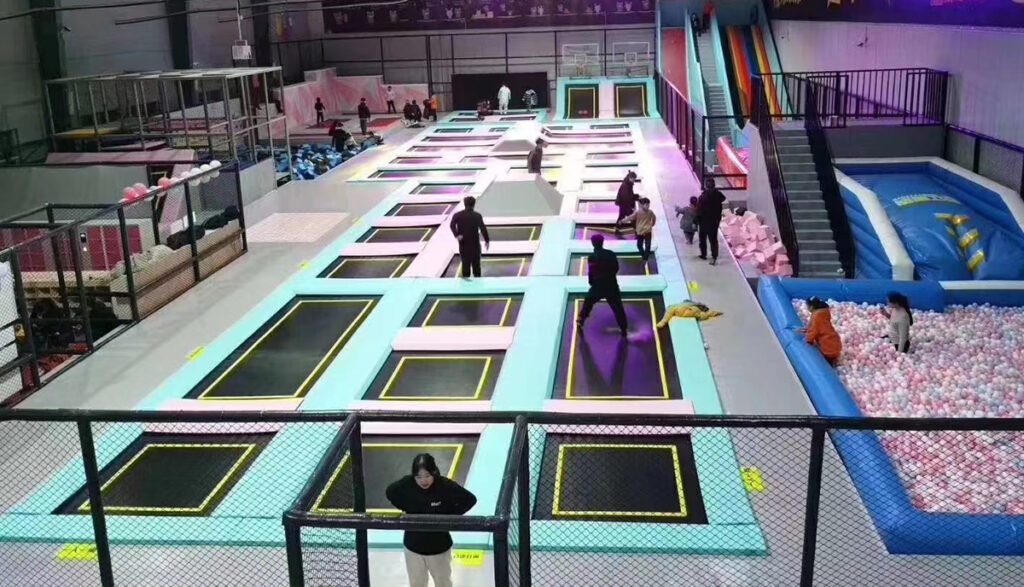Trampoline parks provide a fun form of cardiovascular exercise that can improve heart health, endurance, and overall fitness. Jumping on a trampoline also activates various muscle groups, including the legs, core, and arms, helping to strengthen and tone the body. The repetitive impact of jumping on a trampoline can stimulate bone growth and density, especially in children and teenagers.
Unlike high-impact activities like running or jumping on hard surfaces, indoor trampoline parks offer a low-impact workout that is gentle on the joints. This makes them suitable for people suffering from joint pain or recovering from injury.
Trampoline parks provide opportunities for socializing and bonding with friends, family, and fellow jumpers. Group activities and games on the trampolines can foster teamwork, communication, and cooperation skills.

Growth of the Trampoline Park Industry: A Booming Business
Trampoline parks are becoming increasingly popular. These indoor parks provide a fun and exciting way to exercise and spend time with family and friends. The industry has experienced significant growth, with more than 1,500 trampoline parks in operation worldwide, and more being established rapidly.
Market research indicates that the worldwide trampoline park industry was worth $837.8 million in 2022 and is projected to expand at a 15.6% compound annual growth rate (CAGR) from 2023 to 2032, reaching a value of $3.57 billion. This growth is driven by rising interest in recreational pursuits, particularly among younger generations.

Who's the Target Group for Your Trampoline park?
The target customer base for trampoline parks is diverse and includes individuals of varying ages, interests, and backgrounds. The following are the main target customer groups:
- Kids and Families: Trampoline parks often attract families looking for a fun and active outing. Children of all ages, from toddlers to teenagers, enjoy the thrill of bouncing and playing in a safe environment. Research compiled by REGIONDO states that 35% of trampoline customers are 6–10-year-olds, 26% of trampoline customers are 11–15-year-olds, and 13% of trampoline customers are toddlers. Parents appreciate the opportunity for their children to expend energy while engaging in physical activity.
- Teens and Young Adults: Hosting birthday parties, special events, and group outings can be a great source of revenue for your indoor playgrounds. Party packages may include exclusive use of the party room, catering, decorations, and entertainment options. Depending on the package and the number of parties hosted per week, party booking revenue ranges from hundreds to thousands of dollars per event.Trampoline parks attract teenagers and young adults looking for adventure and social experiences. A group of friends often go to a trampoline park for birthday parties, group outings, or casual get-togethers. The park’s vibrant atmosphere and variety of activities make it an attractive destination for this population.
- Fitness Enthusiasts: Trampoline parks are increasingly attracting fitness enthusiasts looking for alternative exercise options. Trampoline fitness classes offer a fun and effective way to improve cardiovascular fitness, strength, and flexibility. Adults interested in low-impact exercise or trying new fitness trends may become regular visitors.
- Birthday Parties and Special Events: Trampoline parks are popular places for birthday parties, corporate events, team-building activities, and other special occasions. Event planners and organizers looking for a unique and memorable experience for their guests often choose trampoline parks because of their entertainment value and versatility.
- Recreational Visitors: Individuals seeking an enjoyable and active pastime may visit trampoline parks on a whim or as part of their regular leisure activities. Solo visitors, couples, and small groups can head to the trampoline park for a fun and stress-relieving experience.
- Athletes: Trampoline parks often host events and competitions for skilled athletes, including trampoline gymnasts, parkour practitioners, and extreme sports enthusiasts. These athletes are attracted to the park’s specialized equipment and training facilities to hone their skills and compete in organized competitions.

Detailed Explanation of the Cost of Opening A Trampoline Park
Opening an indoor trampoline park can be an exciting and profitable business venture. However, potential owners must consider one-time start-up costs, including trampoline park equipment, building lease or purchase, and construction and renovation expenses.
In addition, there are ongoing costs such as liability insurance, audio-visual equipment, security and monitoring systems, office equipment and furniture, franchise and retail stores, and marketing and advertising expenses.
In this blog post, we will examine these different start-up costs to give aspiring trampoline park owners a better idea of how much they can expect to spend when starting their own park.
| Item Name | Average Amount Range (USD) |
|---|---|
| Site Rent or Purchase | $5,000 - $20,000 per month for rent, $500,000 - $2,000,000 for purchase |
| Building Renovation Cost | $5,000 - $30,000 |
| Trampoline Park Equipment | $10,000 - $120,000 |
| Licenses Plus Utilities | $1,000 - $3,000 |
| Liability Insurance | $5,000 - $10,000 per year |
| Audio and Visual Equipment | $50,000 - $100,000 |
| Security and Monitoring Systems | $10,000 - $20,000 |
| Office Equipment and Furniture | $20,000 - $30,000 |
| Marketing and Advertising Expenses | $10,000 - $30,000 |
| Total Amount | $116,000 - $843,000 |
It’s important to note that these amounts are only estimates, and actual startup costs may vary based on location, size, and other variables. When developing a budget for your indoor trampoline park, be sure to consider all possible expenses to ensure a successful launch.
How Much Does It Cost to Build A Trampoline Park?
Building a trampoline park costs $1M–$3M, including site rental or purchase ($20K–$100K/year or $500K–$2M to buy), equipment ($10K–$120K), renovations ($50K–$500K), and licensing fees. Additional costs for insurance, security, and marketing vary by location and park size.
Site Rent or Purchase
The cost of renting or purchasing a jump trampoline park space varies as per the location, size, and specific requirements of the business. The average cost of leasing or renting a venue for this type of business typically ranges from $20,000 to $100,000 per year, depending on location and space size.
If you plan to purchase a building for an indoor trampoline park, you could expect to pay between $500,000 and $2 million, depending on the location and size of the building. In popular metropolitan areas such as New York or Los Angeles, the real estate market is extremely competitive, and the cost of purchasing is high.
When considering the cost of renting or purchasing a building, it is important to consider other related expenses. For example, you may need to invest in renovations to your building to meet safety regulations and provide necessary amenities for your customers. Depending on the extent of the renovations needed, these costs can range from $50,000 to $500,000 or more.
Building Renovation Cost
Renovation and construction costs are additional costs that you have to invest in because if you want to enhance your existing trampoline park, you have to pay your pennies to get the desired result. Since all entertainment centers or special events require additional amounts in case of emergencies, you will almost always need to have around $5,000 to $30,000 ready to cover all sudden damages.
As a trampoline park owner, you can save on manufacturing costs by contacting many contractors. You can get precise quotes from various companies, compare their prices, and then make the perfect choice. Luckily, if you have a building for your trampoline, that’s a good start.
Trampoline Park Equipment
When it comes to opening an indoor trampoline park, the most important investment is trampoline park equipment. The cost of trampoline equipment can vary greatly based on factors such as size, quality, and quantity.
The latest statistics show that the equipment cost of an indoor trampoline park can reach $10,000 to $120,000. This includes the cost of the trampolines themselves, pads, safety mats, foam pits, and other equipment necessary for a successful trampoline park.
Licenses Plus Utilities
The first step in opening a trampoline park is obtaining the appropriate licenses and permits. These Licensing/registration costs can vary greatly depending on state and local regulations. You are responsible for obtaining all the necessary licenses, permits, and other legal documents to operate a trampoline park.
In the United States, licensing/registration costs average $1,000-$10,000, depending on the size, location, and other factors. Additionally, you will need to purchase the necessary insurance for your trampoline park.
It’s best to research your state and local regulations to get an accurate estimate of the total licensing/registration costs for opening a trampoline park. In some states, the Licensing/registration costs may include:
- Business License: Depending on the state, a business license costs between $50 and $500.
- Liability Insurance: Depending on your level of coverage, liability insurance can cost anywhere from $5,000 to $10,000 per year.
- Health Insurance: This cost may also vary depending on the coverage you require.
- Zoning Laws: Most trampoline parks require some zoning law or government permit.
Audio and Visual Equipment
Audio and visual equipment are important aspects of creating an enjoyable and safe environment at an indoor trampoline park. The cost of audio and video equipment can vary depending on the size and scope of your facility. Still, you can expect to pay an average of $50,000 – $100,000 for a comprehensive setup that includes a sound system, video monitoring, and other related equipment.
Security and Monitoring Systems
Security and monitoring systems are vital to any business, especially in the trampoline park industry. These systems help keep customers and employees safe, prevent unauthorized access, and prevent theft and vandalism.
According to recent statistics, the cost of installing and maintaining these systems can vary greatly depending on the size and complexity of the park. On average, basic security and monitoring systems cost around $5,000 to $10,000, while more advanced systems with high-tech features can cost upwards of $50,000.
Office Equipment and Furniture
Setting up a trampoline park requires office equipment and furniture such as chairs, desks, cabinets, printers, scanners, copiers, staff uniforms, and other office supplies. Depending on the size of the trampoline park, the cost of office equipment, furniture, and supplies can range from $5,000 to $15,000. Fees may vary depending on location, quality, and quantity of items purchased.
Marketing and Advertising Expenses
Marketing and advertising play a vital role in making people aware of the launch of new businesses. Marketing expenses vary based on the type and size of the project. Indoor trampoline parks require an extensive marketing budget to target the desired audience. According to the latest research, the average cost of marketing and advertising to open an indoor trampoline park in the United States is approximately $10,000 – $30,000.
Marketing expenses include all promotional activities, such as email campaigns, social media advertising, print media advertising, website creation, and search engine optimization. Social media advertising is trendy nowadays and attracts the maximum audience’s attention.
How Much Do Indoor Trampoline Park Business Owner Make?
Typically, indoor trampoline parks charge $10 per hour, especially for jumping time. Rates vary in different regions; if your trampoline park is located in an urban area, you can charge a higher fee, and if it’s located in a low area, you’ll need to charge a lower fee. You can also charge extra if your customers use your socks, and you can also charge extra for foods & beverages.
There are many tips that you must follow to increase the profit of your indoor trampoline park business. Improve your trampoline ticketing system, as most customers want to avoid queueing for long periods to get tickets; rather, people prefer to purchase tickets online. Another tip is to offer competitive offers by giving deep discounts to groups. Also, offer attractive deals for birthday parties, conferences, corporate events, and party packages to attract more customers to your trampoline park franchise store.
Moreover, food options are upgraded, and passengers can add different food packages to their tickets at a discounted price.

Start Your Trampoline Parks Project with Lebo Play Now.
Assuming you want to thrive in your trampoline park business, you have to differentiate yourself from competitors as an entrepreneur. Therefore, if you really want to set up an indoor trampoline park, you must determine the types of elements your park must have over other parks and how to provide unique experiences for your customers that compel them to come again and again.
One way to keep customers coming back excitedly and increase the level of fun is to offer adventure indoor play equipment. At Lebo Play, we have everything you plan to build a memorable and outstanding indoor trampoline park.

